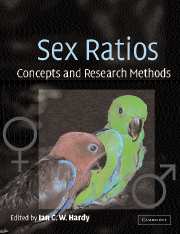Book contents
- Frontmatter
- Contents
- List of contributors
- Preface and acknowledgements
- Part 1 Sex ratio theory
- Chapter 1 Models of sex ratio evolution
- Chapter 2 Optimal sex allocation: steps towards a mechanistic theory
- Part 2 Statistical analysis of sex ratio data
- Part 3 Genetics of sex ratio and sex determination
- Part 4 Animal sex ratios under different life-histories
- Part 5 Sex ratios in plants and protozoa
- Part 6 Applications of sex ratios
- Index
- References
Chapter 2 - Optimal sex allocation: steps towards a mechanistic theory
Published online by Cambridge University Press: 06 August 2009
- Frontmatter
- Contents
- List of contributors
- Preface and acknowledgements
- Part 1 Sex ratio theory
- Chapter 1 Models of sex ratio evolution
- Chapter 2 Optimal sex allocation: steps towards a mechanistic theory
- Part 2 Statistical analysis of sex ratio data
- Part 3 Genetics of sex ratio and sex determination
- Part 4 Animal sex ratios under different life-histories
- Part 5 Sex ratios in plants and protozoa
- Part 6 Applications of sex ratios
- Index
- References
Summary
Summary
Sex-allocation theory is often hailed as the most successful branch of evolutionary ecology, yet its success has been limited to a relatively small number of taxa, mostly haplodiploid insects. Sex ratio variation in vertebrates is still poorly understood. We argue that this is due to the failure of current sex-allocation models to sufficiently take into account the complexities of vertebrate sex determination and life histories. Our main purpose here is to discuss how more ‘mechanistic’ models might be constructed to help answer some of the many open questions regarding vertebrate sex allocation. In particular, we discuss the importance of costs of control, the multidimensional nature of allocation decisions and conflicts over allocation decisions. We give an overview of optimality or evolutionarily stable strategy (ESS) techniques that are useful in analysing sex-allocation problems, and we present a series of models to illustrate several of the concepts and techniques.
Introduction
Sex-allocation theory (Charnov 1982) has been very successful in gaining insight into the ultimate causes of sex ratio variation, but in applications the extent of its success has proven rather taxon-specific. Especially in haplodiploid insects relatively simple models seem to be able to correctly predict qualitative features of sex ratio variation, and sometimes even quantitative predictions have been met with remarkable precision (e.g. Werren 1980, but see Hardy et al. 1998). In contrast, the theory has shed a rather pale light on sex ratio variation in vertebrates.
- Type
- Chapter
- Information
- Sex RatiosConcepts and Research Methods, pp. 26 - 46Publisher: Cambridge University PressPrint publication year: 2002
References
- 58
- Cited by



